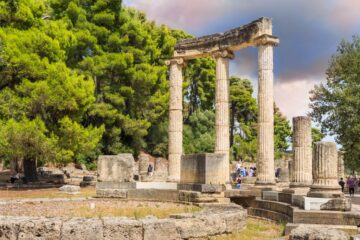Corinth, Mycenae, and Epidaurus full-day tour from Athens. Lunch included
Experience the most authentic Greece on this tour as we follow a route through the Peloponnese, the great Greek peninsula.
| SUMMER | Thursday to Saturday | |||||
| WINTER | Thursday | |||||
| DEPARTURE | 08:00 | |||||
| RETURN | 19:30 | |||||
| INCLUDES |
|
|||||
| NOT INCLUDED |
|
All visits are guaranteed and recommended by real customers, free cancellation (see conditions).
Pick-up service for most hotels in central Athens. Please inform the hotel details at the time of booking.
Free cancellations up to 72 hours before departure
Cancellations within 72 hours or no-show: 100% penalty
1
We leave Athens and make a brief stop at the famous Corinth Canal, which links mainland Greece with the Peloponnese peninsula, separating the Saronic Gulf from the Gulf of Corinth. In ancient times, there were attempts to open a canal to prevent ships from having to circumnavigate the Peloponnese. The excavation of the canal that we see today began in 1882, initiated by a French company. After their bankruptcy, it was the Greeks who completed its construction in 1893. Since then, national maritime routes have been significantly transformed, and the port of Piraeus became the main port of Greece. Currently, the canal measures 6 km in length and 24.5 m in width.
2
We will go back three thousand years to visit the strategic site of powerful Argolis, Mycenae, the city of the cursed Atreides by the gods. Its impressive ruins evoke the memory of this city-fortress from the 2nd millennium BC, described by Homer as “rich in gold.” Ruled by warrior tyrants, plunderers, and hunters, Mycenae was the cradle of Mycenaean civilization. You will begin the visit by admiring the Cyclopean walls, constructed with stones fitted together without any mortar. We pass through the famous Lion Gate, where the masterful symmetry of forms is achieved.
3
We enter the acropolis, where we can visit, and our guides will explain in detail, the history of the entire archaeological site, its palace, and its circle of tombs. Especially noteworthy is the Treasury of Atreus or the Tomb of Agamemnon, the largest and most beautiful of all, with its majestic burial chamber. You will also visit the museum of the archaeological site, where you can explore further artifacts and exhibits related to Mycenae.
4
Later on, we will delve into the culture of the 4th century BC. In a remote area amidst the gentle hills of Argolis, the remains of the sanctuary of Asclepius, the hero and god of Medicine, appear. The oracle of Asclepius was consulted by all of Ancient Greece. Mythology tells us how Asclepius became so wise that he was able to resurrect the dead, earning the enmity of Hades and the jealousy of Zeus. Zeus eventually killed Asclepius, and his remains were buried right here. The beauty of the landscape, the majesty of its lines, and the harmony of its proportions have made the Theater of Epidaurus the most accomplished example in the Ancient world. It was restored in 1954 and adapted for the performance of ancient plays, concerts, and lyrical shows, in which artists like Maria Callas shone. With a capacity of almost 16,000 spectators, the visibility and acoustics are fully guaranteed from any part of the auditorium.
”5″




Tour Reviews
There are no reviews yet.
Leave a Review